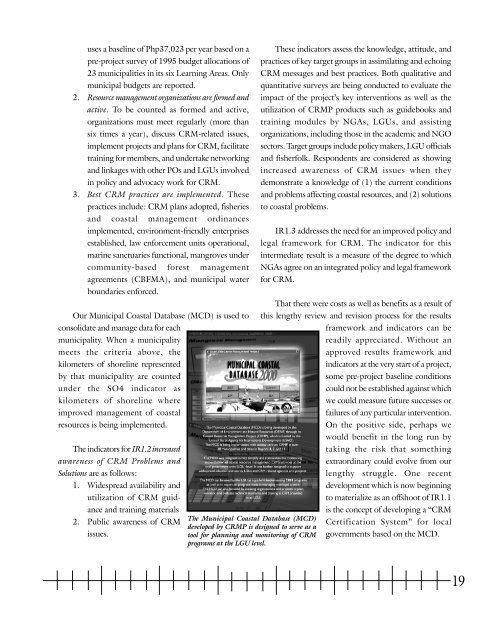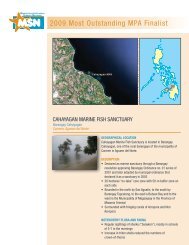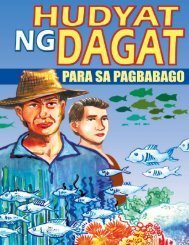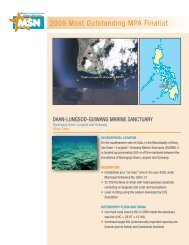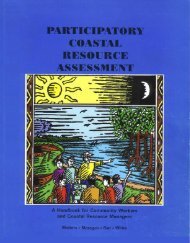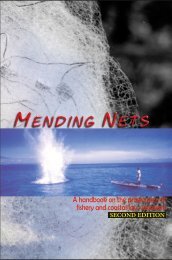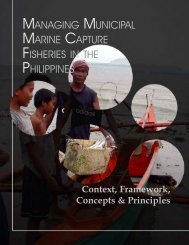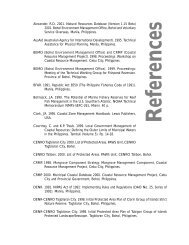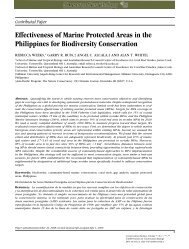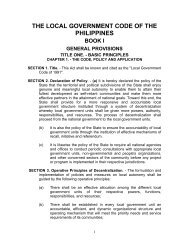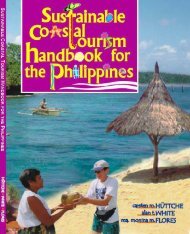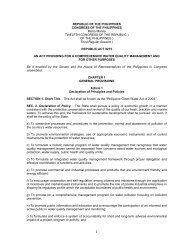Part 2 - Oneocean.org
Part 2 - Oneocean.org
Part 2 - Oneocean.org
- No tags were found...
You also want an ePaper? Increase the reach of your titles
YUMPU automatically turns print PDFs into web optimized ePapers that Google loves.
uses a baseline of Php37,023 per year based on apre-project survey of 1995 budget allocations of23 municipalities in its six Learning Areas. Onlymunicipal budgets are reported.2. Resource management <strong>org</strong>anizations are formed andactive. To be counted as formed and active,<strong>org</strong>anizations must meet regularly (more thansix times a year), discuss CRM-related issues,implement projects and plans for CRM, facilitatetraining for members, and undertake networkingand linkages with other POs and LGUs involvedin policy and advocacy work for CRM.3. Best CRM practices are implemented. Thesepractices include: CRM plans adopted, fisheriesand coastal management ordinancesimplemented, environment-friendly enterprisesestablished, law enforcement units operational,marine sanctuaries functional, mangroves undercommunity-based forest managementagreements (CBFMA), and municipal waterboundaries enforced.Our Municipal Coastal Database (MCD) is used toconsolidate and manage data for eachmunicipality. When a municipalitymeets the criteria above, thekilometers of shoreline representedby that municipality are countedunder the SO4 indicator askilometers of shoreline whereimproved management of coastalresources is being implemented.The indicators for IR1.2 increasedawareness of CRM Problems andSolutions are as follows:1. Widespread availability andutilization of CRM guidanceand training materials2. Public awareness of CRMissues.The Municipal Coastal Database (MCD)developed by CRMP is designed to serve as atool for planning and monitoring of CRMprograms at the LGU level.These indicators assess the knowledge, attitude, andpractices of key target groups in assimilating and echoingCRM messages and best practices. Both qualitative andquantitative surveys are being conducted to evaluate theimpact of the project’s key interventions as well as theutilization of CRMP products such as guidebooks andtraining modules by NGAs, LGUs, and assisting<strong>org</strong>anizations, including those in the academic and NGOsectors. Target groups include policy makers, LGU officialsand fisherfolk. Respondents are considered as showingincreased awareness of CRM issues when theydemonstrate a knowledge of (1) the current conditionsand problems affecting coastal resources, and (2) solutionsto coastal problems.IR1.3 addresses the need for an improved policy andlegal framework for CRM. The indicator for thisintermediate result is a measure of the degree to whichNGAs agree on an integrated policy and legal frameworkfor CRM.That there were costs as well as benefits as a result ofthis lengthy review and revision process for the resultsframework and indicators can bereadily appreciated. Without anapproved results framework andindicators at the very start of a project,some pre-project baseline conditionscould not be established against whichwe could measure future successes orfailures of any particular intervention.On the positive side, perhaps wewould benefit in the long run bytaking the risk that somethingextraordinary could evolve from ourlengthy struggle. One recentdevelopment which is now beginningto materialize as an offshoot of IR1.1is the concept of developing a “CRMCertification System” for localgovernments based on the MCD.19


